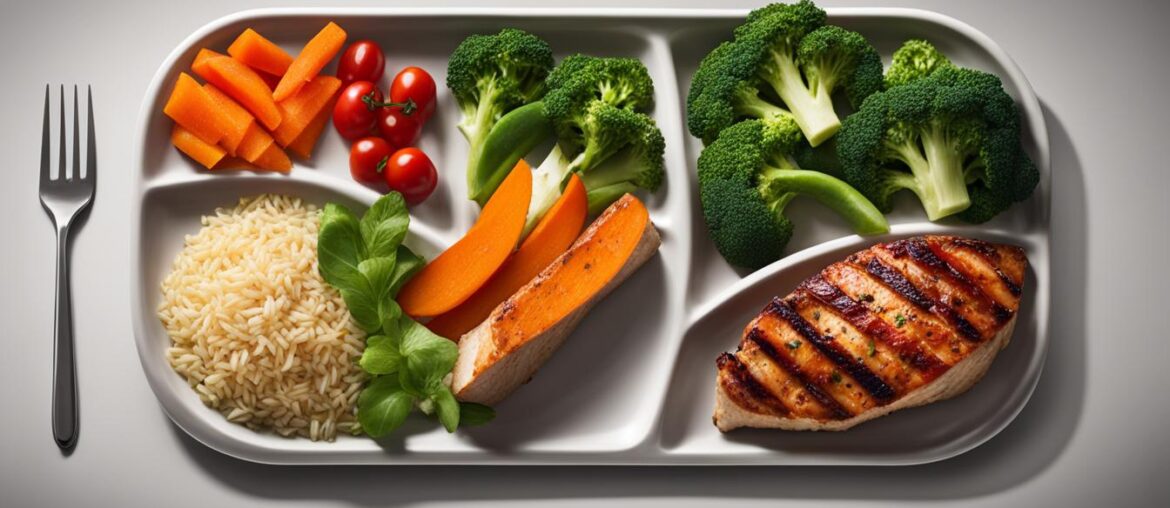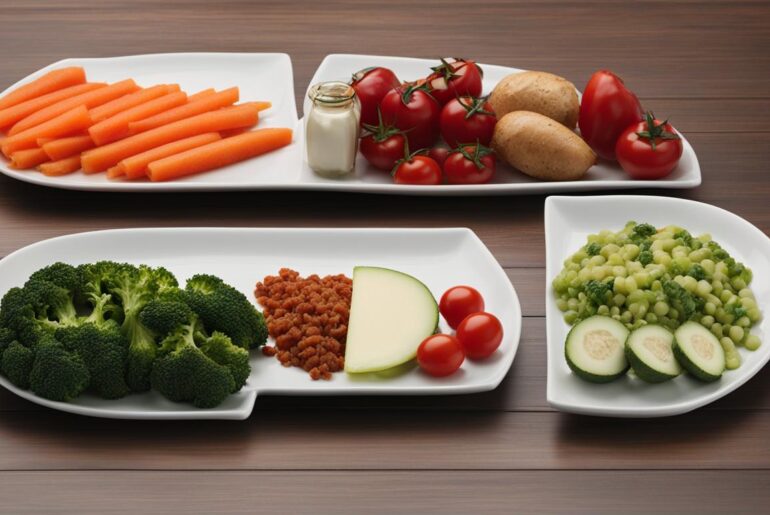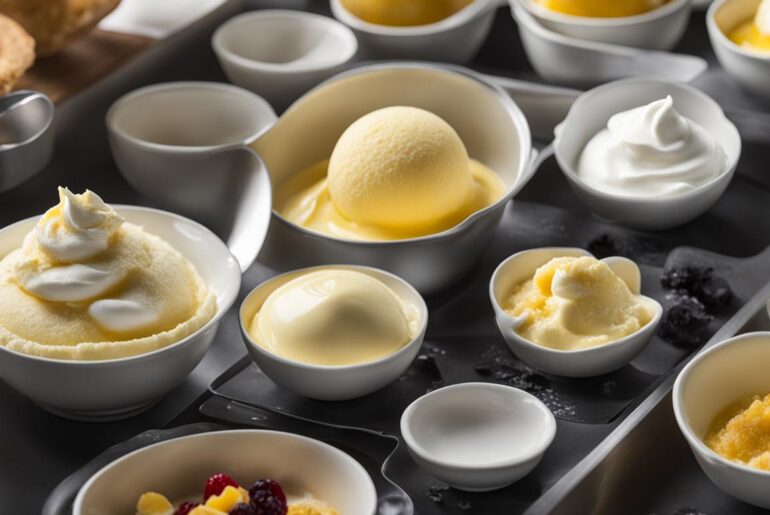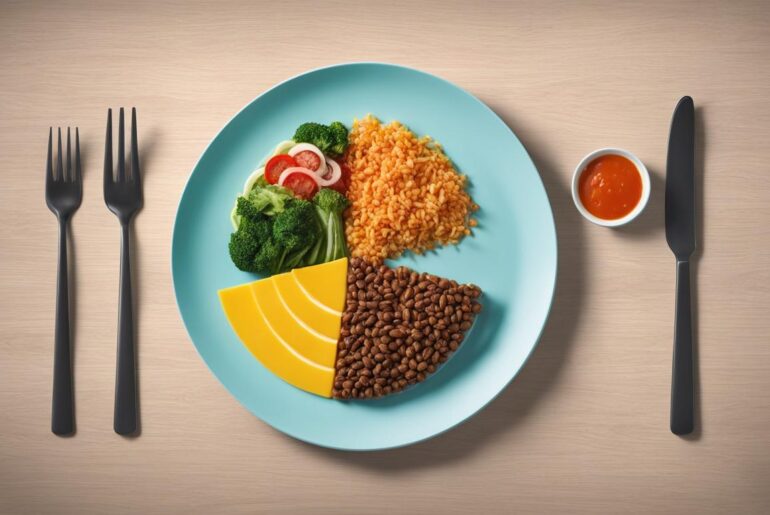I am excited to share with you a comprehensive guide on healthy portion sizes to lose weight. In today’s society, where oversized portions have become the norm, controlling portion sizes is crucial for weight management. Research has shown that portion control can help prevent overeating and contribute to weight loss. By understanding the right portion sizes and implementing effective strategies, you can take control of your eating habits and achieve your weight loss goals.
When it comes to portion control, it’s essential to strike a balance between satisfying hunger and consuming the right amount of food. In this guide, I will provide you with practical tips and techniques to measure and control portion sizes at home and on the go. From using smaller dinnerware to utilizing your plate and hands as guides, you will discover effective ways to keep your portions in check.
Key Takeaways:
- Understanding and practicing portion control is crucial for weight management and achieving your weight loss goals.
- Controlling portion sizes can help prevent overeating and contribute to healthier food choices.
- Using smaller dinnerware and utensils can unconsciously influence portion sizes.
- Your plate can serve as a guide for balancing macronutrients and controlling portion sizes.
- Your hands can be a helpful tool to estimate appropriate portion sizes for different food groups.
Use Smaller Dinnerware for Portion Control
When it comes to portion control, the size of your dinnerware can make a big difference. Using smaller plates, bowls, and serving spoons can unconsciously influence how much food you eat. Studies have shown that when people use larger dishes, they tend to perceive the food as smaller and therefore consume more. By swapping larger dinnerware for smaller alternatives, you can reduce portion sizes and prevent overeating.
Using smaller dinnerware is a simple yet effective strategy for portion control. It tricks your mind into thinking that you’re eating a satisfying amount of food, even if the portion size is smaller. By visually filling up your plate or bowl with less food, you can still enjoy a satisfying meal without overindulging.
In addition to using smaller plates and bowls, consider downsizing your serving spoons as well. When serving food, using smaller utensils can help you exercise better portion control. It prevents you from scooping up large portions and encourages you to be more mindful of the amount you’re putting on your plate.
Use Your Plate as a Portion Guide
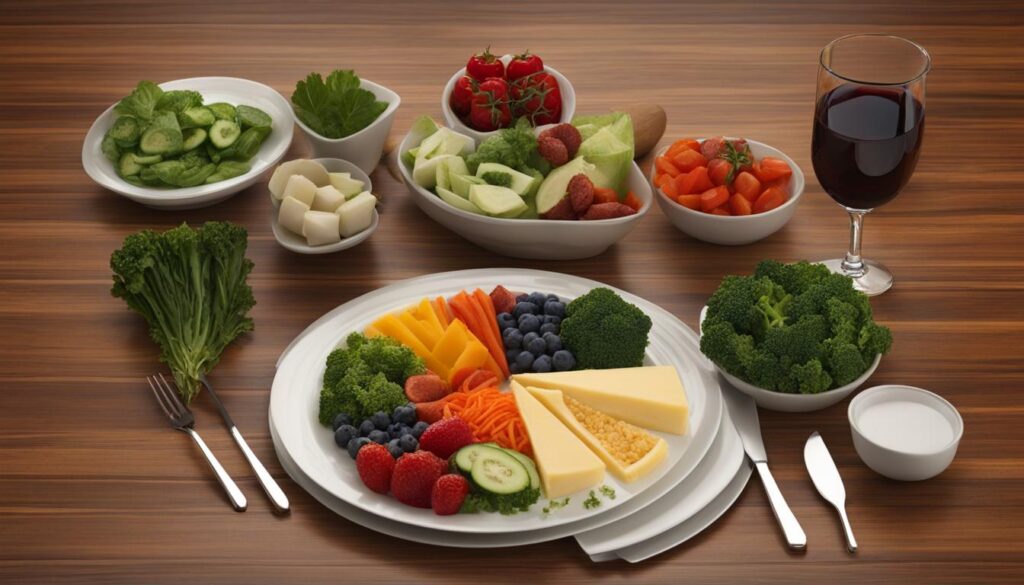
When it comes to portion control, your plate can be a valuable tool. By using your plate as a portion guide, you can ensure a well-balanced meal that includes the right macronutrient ratio. Here’s a simple guide to help you control portion sizes and create a balanced plate:
1. Fill Half of Your Plate with Vegetables or Salad
Vegetables and salad are essential components of a healthy meal. They are rich in vitamins, minerals, and fiber, which are vital for overall health. By filling half of your plate with colorful vegetables, you can ensure you’re getting a variety of nutrients while keeping the calorie content in check.
2. Allocate a Quarter of Your Plate to High-Quality Protein
Protein is crucial for muscle growth, repair, and many other physiological processes. Choose lean sources of protein such as chicken, turkey, fish, tofu, or legumes. By allocating a quarter of your plate to protein, you can meet your protein needs and feel satisfied after your meal.
3. Dedicate Another Quarter of Your Plate to Complex Carbohydrates
Complex carbohydrates, such as whole grains, provide sustained energy and a range of essential nutrients. Opt for whole-wheat bread, brown rice, quinoa, or sweet potatoes. Allocating a quarter of your plate to complex carbohydrates ensures you’re getting enough energy without overdoing it.
4. Limit High-Fat Foods to Half a Tablespoon
It’s important to include essential fats in your diet, but they are calorie-dense, so portion control is crucial. Limit high-fat foods, such as oils, butter, or dressings, to half a tablespoon. This way, you can still enjoy the flavors and benefits of fats without going overboard.
Using your plate as a portion guide helps you visualize a balanced meal with the right macronutrient ratio. It promotes portion control, which is essential for weight management and overall health. By following this guide, you can ensure you’re getting a well-rounded and satisfying meal.
Remember, portion control is a valuable habit that can support your health and weight management goals. By using your plate as a guide, you can create balanced meals that provide the nutrients your body needs, without overeating.
Use Your Hands as a Serving Guide
Your hands can be a helpful guide for portion sizes. By using your hands as a serving guide, you can easily estimate appropriate portion sizes without the need for measuring cups or scales. Here are some guidelines to follow:
- A palm-sized serving of high-protein foods is appropriate for women, while men may need two palm-sized portions. This can include lean meats, fish, poultry, tofu, or legumes.
- A fist-sized portion is suitable for vegetables and salads. Women can have one fist-sized portion, while men may need two. Including a variety of colorful vegetables in your meals is important for obtaining essential nutrients.
- When it comes to high-carbohydrate foods like grains or starchy vegetables, one cupped-hand portion is appropriate for women, while men may need two. It’s important to choose whole grains and include a mix of different carbohydrates in your diet.
- A thumb-sized portion of high-fat foods, such as nuts, avocado, or cooking oils, is suitable for women. Men may need two thumb-sized portions. Including healthy fats in moderation is important for overall health and satiety.
By using your hands as a serving guide, you can easily estimate portion sizes and ensure you’re getting the right amount of nutrients without overeating. Remember, individual calorie needs may vary based on factors such as age, activity level, and specific health goals, so it’s always a good idea to consult with a registered dietitian or healthcare provider for personalized guidance.
Now let’s take a look at a visual representation of portion sizes using your hands as a guide:
| Food Group | Portion Size for Women | Portion Size for Men |
|---|---|---|
| High-Protein Foods | Palm-sized portion | Two palm-sized portions |
| Vegetables and Salads | Fist-sized portion | Two fist-sized portions |
| High-Carb Foods | One cupped-hand portion | Two cupped-hand portions |
| High-Fat Foods | One thumb-sized portion | Two thumb-sized portions |
Ask for a Half Portion When Eating Out

When dining out at restaurants, one major challenge for portion control is the large sizes of the meals served. It’s no secret that restaurant portions can be much larger than what we would typically consume at home. To avoid overeating while still enjoying your favorite dishes, try asking for a half portion.
By requesting a half portion, you can enjoy a satisfying meal without going overboard on calories. This option is especially helpful if you are watching your calorie intake or trying to maintain a healthy weight. Another option to consider is ordering a children’s dish, which often comes in smaller sizes and is perfect for those with a lighter appetite.
Another effective strategy is sharing a meal with a dining companion. Many restaurants are happy to accommodate this request by providing an extra plate. Splitting a main dish not only reduces portion sizes but also allows you to try different items on the menu.
Expert Tip:
“When dining out, consider ordering a starter and a side instead of a main dish. This way, you can still enjoy a variety of flavors, while keeping portion sizes in check.”
Additionally, you can opt for healthier side options such as a side salad or a serving of vegetables. These choices can help fill you up with nutritious options and lower the overall calorie content of your meal. By making these small adjustments, you can still indulge in your favorite foods while maintaining portion control.
It’s also a good idea to ask for any sauces and dressings to be served separately. This way, you can control the amount you add to your meal, preventing unnecessary calories from sneaking in. Lastly, try to avoid buffet-style restaurants where it’s easy to overindulge due to the wide variety and abundance of food choices.
Start All Meals With a Glass of Water
Drinking a glass of water up to 30 minutes before a meal can naturally aid portion control. Water has numerous benefits when consumed before meals, including reducing food intake, promoting feelings of fullness, and helping with hydration and hunger cues.
Research studies have shown that drinking water before meals can have a positive impact on weight management. By starting your meal with water, you can create a sense of fullness that may lead to decreased food intake.
Water is also essential for hydration, and staying well hydrated throughout the day can help control hunger cues and prevent overeating. Additionally, many people often mistake thirst for hunger, and drinking water before a meal can help differentiate between genuine hunger and the need for hydration.
By incorporating this simple habit into your daily routine, you can optimize your portion control efforts and enhance your overall well-being.
As a registered dietitian, I highly recommend starting all meals with a refreshing glass of water to support your weight management goals. Here are some additional benefits of drinking water before meals:
- Reduced food intake: Water has a natural suppressive effect on appetite, leading to decreased consumption of food.
- Feelings of fullness: By filling your stomach with water before a meal, you can experience greater satiety, helping you eat smaller portions.
- Hydration and hunger cues: Adequate hydration is essential for maintaining proper bodily functions, and drinking water before meals can help you meet your daily fluid needs.
Remember, staying hydrated and mindful of your portion sizes can contribute to a sustainable and healthy approach to weight management. Incorporating water before meals into your routine is a simple and effective strategy to support your overall well-being.
Take It Slowly for Portion Control
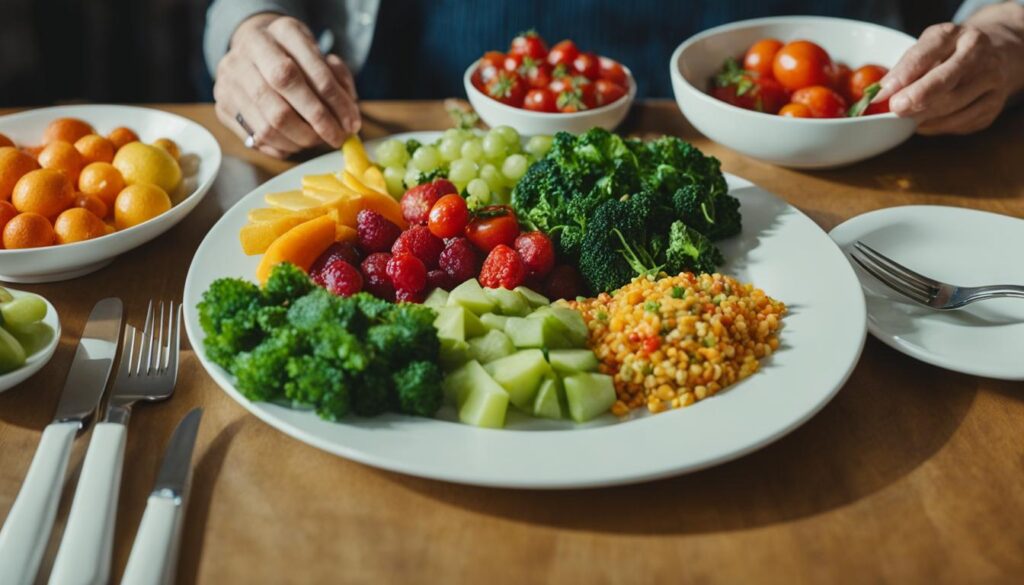
Eating quickly can lead to overeating as it takes time for your brain to register fullness. Slowing down your eating pace can help you reduce your total food intake.
“Eating slowly can increase feelings of fullness and lead to decreased food intake,” says Dr. Jane Wilson, a nutrition expert.
When you eat slowly and mindfully, you can savor the flavors and textures of your food, allowing yourself to fully enjoy the dining experience. By paying attention to each bite, you become more aware of your body’s hunger and fullness cues.
Mindful eating involves being present and focused on your meal, without distractions. Avoid eating in front of the TV or while scrolling through your phone. Instead, create a calm and peaceful environment that allows you to fully engage with your food.
By taking it slowly and mindfully, you’ll not only feel more satisfied with smaller portions but also develop a healthier relationship with food.
Benefits of Eating Slowly:
- Increased feelings of fullness
- Decreased food intake
- Better digestion
- Improved portion control
- Enhanced enjoyment of meals
So, the next time you sit down for a meal, remember to eat slowly, savor each bite, and truly listen to your body’s signals of satiety.
| Quick Eating | Slow Eating |
|---|---|
| Leads to overeating | Promotes portion control |
| Disrupts digestion | Fosters proper digestion |
| Lack of satisfaction | Enhanced enjoyment of meals |
| Disconnected from body’s signals | Increased awareness of hunger and fullness cues |
Conclusion
Controlling portion sizes is a crucial aspect of successful weight loss and weight management. Through strategies such as using smaller dinnerware, following plate and hand serving guides, requesting half portions when dining out, starting meals with water, eating slowly, and developing portion size awareness, you can effectively manage your portion sizes and make healthier choices.
By using smaller dinnerware, such as plates, bowls, and serving spoons, you can visually reduce the amount of food you consume. Studies have shown that using larger dishes can lead to overeating, as the portion appears smaller. On the other hand, swapping to smaller dinnerware can help you regulate your portion sizes and prevent overindulgence.
Using your plate as a portion guide can also be beneficial in determining the optimal macronutrient ratio for a well-balanced meal. By filling half of your plate with vegetables or salad, a quarter with high-quality protein, and a quarter with complex carbs, you can control your portion sizes and ensure a balanced diet. Additionally, using your hands as a serving guide can help you estimate appropriate portion sizes for different food groups.
When eating out, it’s important to be mindful of portion sizes. Asking for a half portion or a children’s dish, sharing a meal with someone, or ordering a starter and side instead of a main dish can help control portion sizes. Choosing options like a side salad or vegetables, requesting sauces and dressings on the side, and avoiding buffet-style restaurants can also aid in portion control.
Starting your meals with a glass of water can naturally assist in portion control. Drinking water before meals can reduce food intake and promote a feeling of fullness, helping you avoid overeating. Additionally, eating slowly and without distractions allows your brain to register feelings of fullness, leading to a decreased food intake and better portion control. Developing portion size awareness is key to managing your weight effectively and improving your overall wellbeing.

